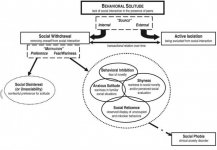A ‘‘Multitude’’ of Solitude: A Closer Look at Social Withdrawal and Nonsocial Play in Early Childhood
by Robert J. Coplan and Mandana Armer
[SIZE=-1]Child Development Perspectives, 2007 [/SIZE]
It has long been argued that social withdrawal in early childhood is a risk factor for later socioemotional difficulties. However, in recent years, researchers have begun to make distinctions between types of social withdrawal in young children, including shyness, social disinterest, and social avoidance. In this article, we review the literature on multiple forms of social withdrawal in early childhood. In particular, we focus on (a) theoretical and empirical distinctions between shyness, social disinterest, and social avoidance; (b) links between these constructs and children’s social and nonsocial play behaviors with peers; and (c) implications for children’s psychosocial adjustment. As well, we provide suggestions for future research, particularly on the relatively understudied construct of social disinterest and the virtually unexplored phenomenon of social avoidance...
It would appear that extremely shy children might benefit from targeted intervention programs designed to reduce social fear and anxiety and promote competent social interactions. In contrast, social disinterest may not be the cause for significant concern, particularly in younger children. Social avoidance may warrant concern, but empirical studies are needed. We are hopeful that subsequent research will continue to help clarify when it might be acceptable to ‘‘leave a child alone.’’
Full article
by Robert J. Coplan and Mandana Armer
[SIZE=-1]Child Development Perspectives, 2007 [/SIZE]
It has long been argued that social withdrawal in early childhood is a risk factor for later socioemotional difficulties. However, in recent years, researchers have begun to make distinctions between types of social withdrawal in young children, including shyness, social disinterest, and social avoidance. In this article, we review the literature on multiple forms of social withdrawal in early childhood. In particular, we focus on (a) theoretical and empirical distinctions between shyness, social disinterest, and social avoidance; (b) links between these constructs and children’s social and nonsocial play behaviors with peers; and (c) implications for children’s psychosocial adjustment. As well, we provide suggestions for future research, particularly on the relatively understudied construct of social disinterest and the virtually unexplored phenomenon of social avoidance...
It would appear that extremely shy children might benefit from targeted intervention programs designed to reduce social fear and anxiety and promote competent social interactions. In contrast, social disinterest may not be the cause for significant concern, particularly in younger children. Social avoidance may warrant concern, but empirical studies are needed. We are hopeful that subsequent research will continue to help clarify when it might be acceptable to ‘‘leave a child alone.’’
Full article


